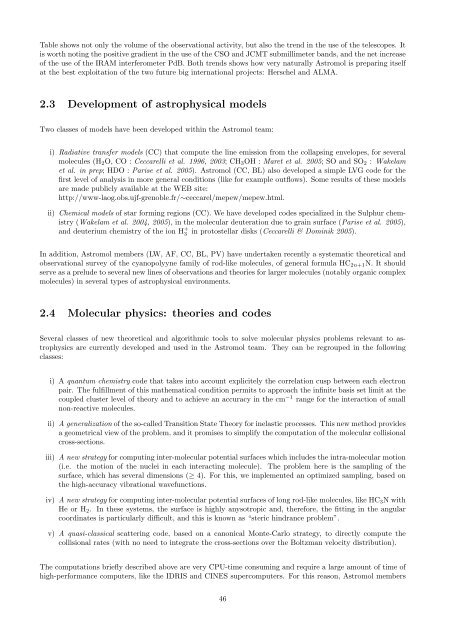Untitled - Laboratoire d'Astrophysique de l'Observatoire de Grenoble
Untitled - Laboratoire d'Astrophysique de l'Observatoire de Grenoble
Untitled - Laboratoire d'Astrophysique de l'Observatoire de Grenoble
Create successful ePaper yourself
Turn your PDF publications into a flip-book with our unique Google optimized e-Paper software.
Table shows not only the volume of the observational activity, but also the trend in the use of the telescopes. It<br />
is worth noting the positive gradient in the use of the CSO and JCMT submillimeter bands, and the net increase<br />
of the use of the IRAM interferometer PdB. Both trends shows how very naturally Astromol is preparing itself<br />
at the best exploitation of the two future big international projects: Herschel and ALMA.<br />
2.3 Development of astrophysical mo<strong>de</strong>ls<br />
Two classes of mo<strong>de</strong>ls have been <strong>de</strong>veloped within the Astromol team:<br />
i) Radiative transfer mo<strong>de</strong>ls (CC) that compute the line emission from the collapsing envelopes, for several<br />
molecules (H2O, CO : Ceccarelli et al. 1996, 2003; CH3OH : Maret et al. 2005; SO and SO2 : Wakelam<br />
et al. in prep; HDO : Parise et al. 2005). Astromol (CC, BL) also <strong>de</strong>veloped a simple LVG co<strong>de</strong> for the<br />
first level of analysis in more general conditions (like for example outflows). Some results of these mo<strong>de</strong>ls<br />
are ma<strong>de</strong> publicly available at the WEB site:<br />
http://www-laog.obs.ujf-grenoble.fr/∼ceccarel/mepew/mepew.html.<br />
ii) Chemical mo<strong>de</strong>ls of star forming regions (CC). We have <strong>de</strong>veloped co<strong>de</strong>s specialized in the Sulphur chem-<br />
istry (Wakelam et al. 2004, 2005), in the molecular <strong>de</strong>uteration due to grain surface (Parise et al. 2005),<br />
and <strong>de</strong>uterium chemistry of the ion H + 3 in protostellar disks (Ceccarelli & Dominik 2005).<br />
In addition, Astromol members (LW, AF, CC, BL, PV) have un<strong>de</strong>rtaken recently a systematic theoretical and<br />
observational survey of the cyanopolyyne family of rod-like molecules, of general formula HC2n+1N. It should<br />
serve as a prelu<strong>de</strong> to several new lines of observations and theories for larger molecules (notably organic complex<br />
molecules) in several types of astrophysical environments.<br />
2.4 Molecular physics: theories and co<strong>de</strong>s<br />
Several classes of new theoretical and algorithmic tools to solve molecular physics problems relevant to astrophysics<br />
are currently <strong>de</strong>veloped and used in the Astromol team. They can be regrouped in the following<br />
classes:<br />
i) A quantum chemistry co<strong>de</strong> that takes into account explicitely the correlation cusp between each electron<br />
pair. The fulfillment of this mathematical condition permits to approach the infinite basis set limit at the<br />
coupled cluster level of theory and to achieve an accuracy in the cm −1 range for the interaction of small<br />
non-reactive molecules.<br />
ii) A generalization of the so-called Transition State Theory for inelastic processes. This new method provi<strong>de</strong>s<br />
a geometrical view of the problem, and it promises to simplify the computation of the molecular collisional<br />
cross-sections.<br />
iii) A new strategy for computing inter-molecular potential surfaces which inclu<strong>de</strong>s the intra-molecular motion<br />
(i.e. the motion of the nuclei in each interacting molecule). The problem here is the sampling of the<br />
surface, which has several dimensions (≥ 4). For this, we implemented an optimized sampling, based on<br />
the high-accuracy vibrational wavefunctions.<br />
iv) A new strategy for computing inter-molecular potential surfaces of long rod-like molecules, like HC3N with<br />
He or H2. In these systems, the surface is highly anysotropic and, therefore, the fitting in the angular<br />
coordinates is particularly difficult, and this is known as “steric hindrance problem”.<br />
v) A quasi-classical scattering co<strong>de</strong>, based on a canonical Monte-Carlo strategy, to directly compute the<br />
collisional rates (with no need to integrate the cross-sections over the Boltzman velocity distribution).<br />
The computations briefly <strong>de</strong>scribed above are very CPU-time consuming and require a large amount of time of<br />
high-performance computers, like the IDRIS and CINES supercomputers. For this reason, Astromol members<br />
46




